Kefir. You will likely hear it pronounced incorrectly here in the states as KEE-fer, but the correct way is more like ke-FEER.
What is it? It is fermented milk. OK, ok, don't freak out. You eat fermented milk all the time; cheese, yogurt, sour cream, etc.
But this is a little different than you might be used to. If you have ever had a drinkable yogurt, that is as close as you are going to come to understanding what Kefir is.
You might have even purchased something called kefir in a health food store at some point, but you should be aware it is not really kefir, it is a poor extrapolation of kefir. Still healthy, but not as healthy as the real thing.
Why is kefir so healthy? Not only are you getting the benefits of dairy, but you are also getting probiotics for your GI tract.
You know those little critters. You see commercials all the time touting the wonders of yogurt and it's 2 or 3 probiotics. But true kefir has thirty-four of them. Nope, not a typo. 34. What about the knock-off version you find in health food stores? Only 7 of them. That's right. They have only managed to pull out and be able to reproduce 7 of the 34 probiotics to mass produce in factories.
Where are they getting those 7 friendly flora from? Here.
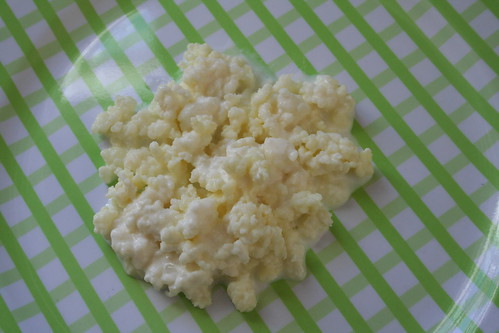
Here are a few of them on a spoon. The little grains, the individual ones look a bit like grains of rice, reproduce and sometimes they are together, sometimes apart. I've had so many stick together than the matrix was the size of my fist.
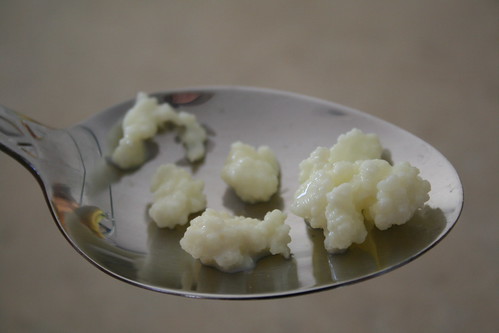
A dear internet friend sent these to me. Turns out we have much in common, and she knew I was out of these. She shipped me about a 1/2 cup of them so I could get started again.
How do kefir grains grow, lend probiotics to the milk they are fermenting, and reproduce? By eating sugar. In this case, lactose, the sugar in milk. Anyone with lactose intolerance reading this? They can be shipped easily enough by giving them a bit of powdered milk to coat them for the journey.
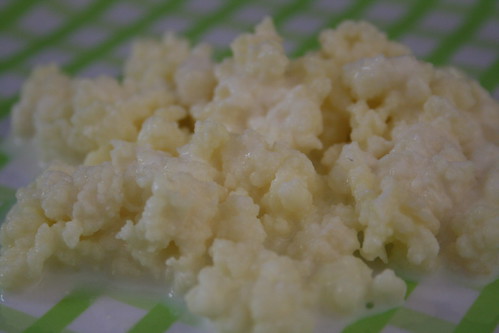
I'm going to show you how I got this batch going yesterday. They smelled wonderful, in great healthy shape, so they survived the extended journey just fine. It took a bit long for me to get them.
Have I ever mentioned how much I love wide mouthed jars? I use them for everything.
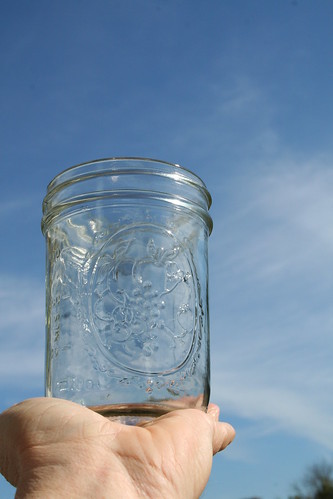
The grains have been in the refrigerator to slow their growth and need for lactose so they are cool when I put them into the jar.
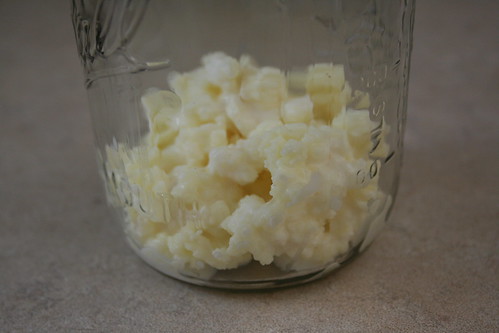
Give them a bit of milk. I'm not going to give them a lot, because they are just waking up. I'll change it out in 24 hours.
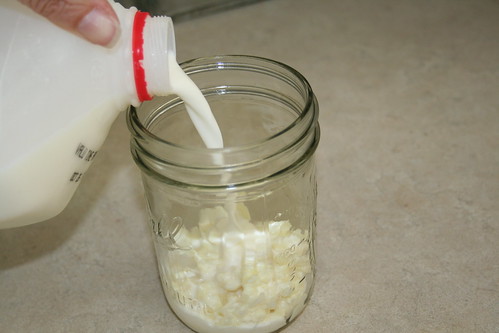
I have done kefir several times. The first time was when we were milking 5 goats and had plenty of raw milk to go around. The grains LOVED it! Then my little dairy goat herd slowly diminished and I lost my grains due to moving. When I tried to start up grains again with store bought milk, I was completely unsuccessful.
No one knows how to make grains. All grains are descended from stock that is passed from person to person. Through time, they seem to adapt just slightly. I suspect the grains I was trying to use in pastuerized milk were not well adapted to it. I have been assured that many grains do just fine in store milk. I believe these have been growing there and they seem to be very healthy and happy, so I have high hopes.
Put on a lid, so bacteria from the air do not enter.
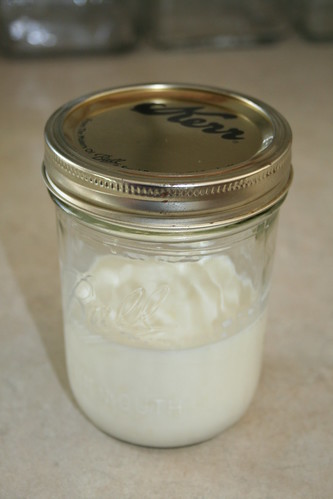
And set aside somewhere in a dark place.
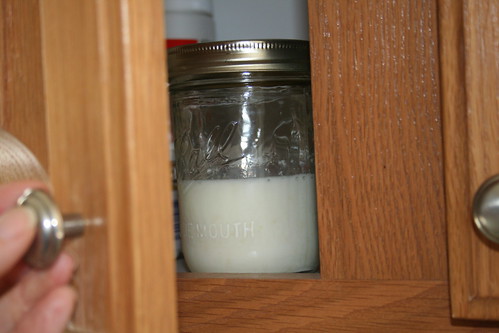
It's good to give the jar a swishing around a couple of times a day to keep the milk mixed and in contact with the grains.
And if you are like me...
Give yourself a little note so you remember what on earth is in your cupboard!

Fermenting fer ewe,
~Faith
.
Beautiful! I have heard of kerif, but I have never tried it. My husband and I do like quark though. Ah for a milking heard!
ReplyDeleteoooh, they look great! mine have been napping in the fridge for the last couple days, i haven't had the chance to get more milk for them or us!
ReplyDeleteI have been wanting to dabble in kefer as well! Maybe when you get a batch under your belt...you can teach me?
ReplyDeleteHm... I've heard of this, but didn't know exactly how to do it. What type of milk do you use (whole/skim/etc.)? And pasteurized milk works too? How does it taste? I may have to borrow a few grains from you once you get your supply built up and try this out... looks very interesting! Thanks for sharing the pics...
ReplyDeleteJo,
ReplyDeleteI never have had the opportunity to try quark. Are you making it, or buying it?
~Faith
Icebear,
ReplyDeleteI like kefir the best when it's had a slow ferment in the fridge, for about a week with the lid screwed tightly down. Have you tried that yet?
~Faith
SBF,
ReplyDeleteI would love to!
~Faith
Beth,
ReplyDeleteWith adapted grains, you should be able to use any milk, just make sure it is not lactose free. LOL
However, whole milk is always going to be the healthiest. Dairy calcium is only readily absorbed by the body when it is in tandem with the natural fats in the milk. God always knows what He is doing when He creates foods for us. We are meant to eat them whole so the nutrients are perfect for our systems in the correct ratios.
~Faith
I've had kefir grains that we've been fermenting for a couple years now-love those little buggers! LOL I've never known the correct pronunciation of kefir, though-thanks! I've done it on the counter & in the fridge, too. I use raw milk. Great pics! Holly
ReplyDelete